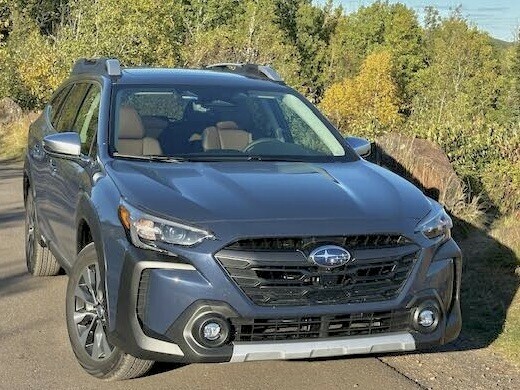Outback has become refined way to go

The Subaru Outback is a vehicle I’ve road-tested and reviewed numerous times in recent years, but as the model-year changes with the calendar, it’s already time to try “next year’s” models of some cars.
That’s the case with the 2025 Subaru Outback Touring XT I recently drove on my appointed rounds for a week in the Northern Minnesota region where I live — and where the chances of harsh winter weather tends to make Subarus a logical and available vehicle to handle whatever Mother Nature might dream up.
Of course, when winters are mild, such as what we had last winter in Duluth, Subarus are just as satisfying and dependable for everything from driving to the cabin or fishing on a Boundary Waters lake.
Anyone researching the evolution of a contemporary auto company needs to place Subaru among the top subjects of evaluation. For about a half-century, Subaru has been chasing fellow-Japanese manufacturers like Toyota, Honda and Nissan, and refinement has eliminated most of the various quirks while staying stubbornly on its own course.
The company concept has been to build sturdy little vehicles and power them with flat-opposed 4-cylinder engines, mostly, which are positioned flat with the crankshaft in the middle and the cylinders traveling horizontally in opposite directions.
Safety and modern technology have been at the forefront as well, with rigid platforms underpinning as much comfort as could fit in.
Subaru builds the subcompact Impreza, plus its WRX spinoff, then moves up to the Legacy and onward to the Crosstrek, Outback, Forester and Ascent, covering nearly every possible niche for anyone seeking a reliable family vehicle with sturdy enough features to last indefinitely, as a compromise between cars and SUVs.
For 2025, the refinement has nearly exhausted Subaru’s objective advancements, if the Outback is any indication. Large enough to carry five adults while still having a spacious rear stowage area, with a waterproof floor panel protecting whatever you’re hauling, the interior blew me away because of the rich, caramel-colored Nappa Leather bucket seats and fold-down second row.
Not only were the seats attractive, but very comfortable and supportive to your body, with the driver’s seat having 12-way adjustments and 4-way lumbar adjustments, while the front passenger seat has 8-way power adjustments.
If that’s not enough for you as you ride along on a trip, volunteer to drive so you can experience the rest of the adjustments. The front buckets are both heated and ventilated, and the rear seats are also heated.
The driving experience is enhanced by a thick, leather-wrapped steering wheel, with short but effective fiberglass paddles affixed to either side so you can shift the 260-horsepower engine manually. While it has a CVT (continuously variable transmission), there are eight built-in detents in the shift cable so you can feel like you’re shifting through an 8-speed manual.
I have gotten to the point where having paddles is a deal-maker or deal-breaker for the next vehicle we’ll buy, particularly because paddles help so much for descending Duluth’s many steep avenues.
The center stack is filled with Subaru’s Starlink, an 11.6-inch vertical navigation and information screen. As refinements go, you have a potent Harman Kardon stereo audio system, and the various contemporary safety features abound for front and rear accident avoidance alerts and active aids such as blind-spot detection and rear cross-traffic alert.
Symmetrical all-wheel drive is standard, of course, and the driver-assist system features eyesight-level control with advanced emergency steering and distraction mitigation.
The sticker price for the loaded 2025 Outback Touring model is $44,356, which is pretty steep for what used to be strictly bargain-priced subcompacts, but not bad for all that’s contained.
Back outside the Outback, there is a roof-rack that is not only a neat feature but it has integrated retractable crossbars to aid both in tie downs if you haul something on the roof, and aerodynamics when you aren’t.
The wheels are styled 18-inch machine-finished in a sporty dark colored pattern.
The normally aspirated standard 2.5-liter engine is supplanted with the more powerful 2.4-liter powerplant which delivers 260 horsepower because it is turbocharged. That not only gives the Outback sporty-car acceleration and performance, but it also, unfortunately, eats into the fuel economy potential. We got between 24 and 29 miles per gallon, which fit the EPA computer estimates of 22 city and 29 highway.
I would prefer more in my fuel economy, but around town mostly and city driving, that was acceptable. Especially when you’re nestled down into those plush leather seats and paddle-shifting your way up and down steep hills without hesitation on the way up and without riding your brakes on the way down.
Not sure what Subaru can do for further refinement in the Outback, but when
they do something, I want to test it.
